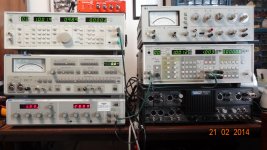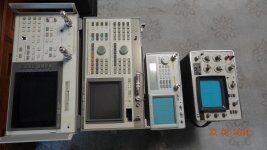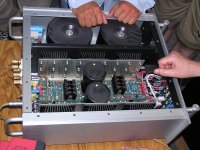If you want someone to take you seriously, you need to provide much more:
If I were to interpret your graphs as normalized to 1V=0dBV, you identified magnetic distortions as an 8th harmonic at -130dB. Good luck hearing that.
Sorry to be so blunt -- I dont need for you to take me seriously. Its been a subject LONG before D.Self's book existed which does not treat the subject thoroughly. And, like I said before -- at higher current the levels as in power amps the distortion will be higher. Maybe even audible. First to test will be OPS Re power resistors. If and when I feel like doing more, for my own curiousity, you'll be the first to know. In the meanwhile, I would recommend builders not place signal wires, signal ground leads against/near the chassis. Ferrous materials, in general, could prevent those ultra low SIM numbers from being realized.
An issue regarding clipping is the way it clips... hard or soft... as well as frequency of clipping, and depth of clipping/over-drive will determine the harmonic profile being produced by the amplifier. That is something hard to control for comparison testing.
THx- RNMarsh
Last edited:
There are plenty of old school domestic amplifiers that exhibit sticking, with associated very fast slew rate recovery.
View attachment 401980
Dan.
Like ancient opamp phase reversal, but again - I hope we do not speak about such amplifiers and we do not create such designs. IMO, clipping is not a scarecrow in a well designed amplifier.
Last edited:
Sure. I would have hoped anyone sane understood this. Or probably they use some supermarket $20 amplifiers.
Actually, I saw this done in a well known brand power amp and tried it. The affect with low effec speakers was like that of compression when attempting by user to attain higher spl's. And, didnt like the sound... said it seems compressed. Might have been just as well to let it clip, i suppose.... but then it does save tweeters. But doesnt sell amps.
I keep coming back to the conclusion that you need more power and greater effec speakers and maybe a group of them in bi-tri amp to get it done well. I dont see any way around it for a perfectionist system. Otherwise let 'em clip like hell, as they do now anyway and sound, generally awful to listen to IMO.
I know the difference as I have built such systems. An alternative that is almost affordable and less complex is the new Quads and a high power amp. Wont play loud or go deep but wont clip amps either. With a pair of 450W/8 mono-blocks and these speakers, the results can be superb.
Anyone can make a high power amp just to try and see the result of less clipping is this --- you need a two pair of stereo amps with balanced (XLR) inputs. Wire the + of the left and use the - of the right to the preamp output. Then, take the OP from the + of each channel. Then try your new high power mono-block amp.
Next? A CFA bridged amp of very low distortion. Did that also... but its your turn now. Can you do it? I'll follow along.
THx-RNMarsh
Last edited:
Sorry to be so blunt -- I dont need for you to take me seriously.
Don't worry, I don't, and nobody having basic EM understanding won't as well. Sorry to be so blunt myself - as also others have noted, you did not provide any evidence, just some cooked up results to make a point and impress those less knowledgeable. The only remarkable information I got so far is that you have an AP2700, hopefully you will use that wonderful tool to investigate real problems and find real solutions.
It strikes me spontaneously a new product on this topic:
A shield around the living room to shield the Earth's magnetic field 😀
I would not worry about this because the ac component is very low.
Faraday shielding is much more worthwhile.
All the more reason to use speakers with more sensitivity than 84.Hi Richard,
Unfortunately, clipping happens. Unless, of course, you have VERY big amplifiers with decently efficient speakers. At RMAF 1996 Peter Smith and I demonstrated the issue using a peak/average digital power meter I designed. We played Rickie Lee Jones "Getto of My Mind" from her Flying Cowboys album in a typical hotel room at realistic (but not overly loud) levels using quality loudspeakers with 84 dB efficiency. The Denon 250 wpc amp we used clipped, while average power out of the amp per channel was less than 2W. You have to see it to believe it.
Clipping happens more often than you think. Its too bad virtually no audiophile amplifiers have honest clipping indicators.
Bottom line: don't dismiss clipping issues.
Of course, the plethora of crappy, compressed program material lulls us into complacency about clipping.
Cheers,
Bob
Also since most sources are digital you are not likely to go beyond 0dB.
If you are using a phono record for a source, the peaks are mostly dust and scratches.
Audio would have clipped earlier in the recording chain.
Don't worry, I don't, and nobody having basic EM understanding won't as well. Sorry to be so blunt myself - as also others have noted, you did not provide any evidence, just some cooked up results to make a point and impress those less knowledgeable. The only remarkable information I got so far is that you have an AP2700, hopefully you will use that wonderful tool to investigate real problems and find real solutions.
Waly,
I do understand where you are coming from. I just dont want to spend that much time on it. I spent my whole adult life in University/government R&D (EE project coordination for high energy, pulsed power physics projects mostly). I get it. I just put it out there to think about and pursue if you want to. This isnt a ref journal being published so I just put out something that is over looked and can be an issue for those who want to know more. And, yes just to make a point.
[I have a lot of test equipment and always have as well as MicroCap etal I use all the time.]
__________________________
Lets do a bridged CFA amp. What's the best topology for that?
THx-RNMarsh
Last edited:
Hi Guys
"Lets do a bridged CFA amp. What's the best topology for that?"
One that works well would be functionally equivalent to the Bryston 28B - not a CFA amp. But...
They use identical power amp modules driven by a cross-coupled pair of diff-SE input stages. These are the usual circuits but with their inputs crossed, so one amp is driven in-phase and the other out-of-phase. The advantage to the crossed input circuit is that the impedance looking into XLR pin-2 and pin-3 is the same. Self showed that with the standard diff-input stage that these impedances are far from identical.
The separate balanced input circuit allows a level control between that and the PAs.
Otherwise, use the "favourite" or "best performing" amp for each PA.
Have fun
Kevin O'Connor
"Lets do a bridged CFA amp. What's the best topology for that?"
One that works well would be functionally equivalent to the Bryston 28B - not a CFA amp. But...
They use identical power amp modules driven by a cross-coupled pair of diff-SE input stages. These are the usual circuits but with their inputs crossed, so one amp is driven in-phase and the other out-of-phase. The advantage to the crossed input circuit is that the impedance looking into XLR pin-2 and pin-3 is the same. Self showed that with the standard diff-input stage that these impedances are far from identical.
The separate balanced input circuit allows a level control between that and the PAs.
Otherwise, use the "favourite" or "best performing" amp for each PA.
Have fun
Kevin O'Connor
Bridged amps do cancel PSU ripple and even harmonics. But it is usually not that simple as to connect two channels of a dual-mono amplifier into a bridge, for the reason of doubled current through output devices. The amplifier must be designed for bridge operation from the very beginning.
P.S.: I have once almost destroyed a Cello amplifier (bridge) by a stupid square wave test. Cross conduction current.
P.S.: I have once almost destroyed a Cello amplifier (bridge) by a stupid square wave test. Cross conduction current.
Last edited:
Lets do a bridged CFA amp. What's the best topology for that?
THx-RNMarsh
Check out the Marantz MA9s2 this is egzactly what You looking for.
Sajti
A circlotron in my opinion.Lets do a bridged CFA amp. What's the best topology for that?
Bridged amps do cancel PSU ripple and even harmonics. But it is usually not that simple as to connect two channels of a dual-mono amplifier into a bridge, for the reason of doubled current through output devices. The amplifier must be designed for bridge operation from the very beginning.
P.S.: I have once almost destroyed a Cello amplifier (bridge) by a stupid square wave test. Cross conduction current.
I have tried it also. Works but yes, can blow some amps with weak OPS.... best to use with higher Z speakers if you want to give it a quick try to see effect on your sound system.
it is pretty easy to do with VFA topology. BUT, a bridged CFA would be appropriate for this CFA discussion/design place. An bridged amp which does not clip or seldom is a real treat to hear. And, would be a good learning experience with new issues to solve.
THx-RNMarsh
Last edited:
Last edited:
Slightly OT
I have a big and heavy 'boat anchor' here - an amp from Wilson Watchdog subwoofer that I got as "non-working" (it was part of the deal) The printing on it says 'Electronics designed by Richard Marsh' Since it is mono, I had zero motivation so far to open it up and see what's inside and what's wrong with it. Do you think it is worth fixing? Does it use any exotic/unobtanium parts?
Thanks,
Richard, a I have a question for youyes, old design. Cant change everything to copper or aluminum.... just what is in my control. BTW-- Other newer models use plastic power devices... and same for MOSfets amps (for oem). Even less steel involved.
I have a big and heavy 'boat anchor' here - an amp from Wilson Watchdog subwoofer that I got as "non-working" (it was part of the deal) The printing on it says 'Electronics designed by Richard Marsh' Since it is mono, I had zero motivation so far to open it up and see what's inside and what's wrong with it. Do you think it is worth fixing? Does it use any exotic/unobtanium parts?
Thanks,
Wilson put them inside enclosures without sufficent heat removal.... I would look for internal fuses first and thermal cutout/relay/protection. The amp is a VFA with balanced in and out (bridged)... may have had an output connected to ground accidently. Very high power and very low distortion. You can also get another and use them for a dual channel operation full range. No strange nor hard to find parts are used so it ought to be cost effective to fix.
See if you can get another one that does not work and you'll have a great pair of mono-blocks to put into a chassis. It is capable of 900W/4 at very low thd. DW didnt have any elec tech people so they just went back to external amps of your choice for thier woofer. If you keep it as is, then be sure not to mount it inside their cabinet without providing a way for extra cooling. Or put it outside the cabinet.
THx-RNMarsh
See if you can get another one that does not work and you'll have a great pair of mono-blocks to put into a chassis. It is capable of 900W/4 at very low thd. DW didnt have any elec tech people so they just went back to external amps of your choice for thier woofer. If you keep it as is, then be sure not to mount it inside their cabinet without providing a way for extra cooling. Or put it outside the cabinet.
THx-RNMarsh
Last edited:
Dear Richard, thanks for the info, I appreciate it!..The amp is a VFA with balanced in and out (bridged)...
... No strange nor hard to find parts are used so it ought to be cost effective to fix.
That is highly unlikely, I can not imagine amps from 10k subwoofers just 'floating around' 😀See if you can get another one that does not work and you'll have a great pair of mono-blocks to put into a chassis.
Regards,
We cant hear compression -- Really?
Just in time -- The latest issue of AES has an article about compression and its audibility.... including perceptual affects of compression. "Perceptual Effects of Dynamic Range Compression in Popular Music recordings; J.AES Vol 62, No 1/2 2014. Concluded we dont hear it... must be something else about compression.
I'm over simplifying but not by much.
BTW -- from their list of 15 pop music sources used in tests -- the peak-to-average ratio of the Original was 10-14dB.
Did they check for amps clipping?
[They used Adam P22-A monitors. at 83dB spl from 190cm distance in a sound proof booth.]
THx-RNMarsh
Just in time -- The latest issue of AES has an article about compression and its audibility.... including perceptual affects of compression. "Perceptual Effects of Dynamic Range Compression in Popular Music recordings; J.AES Vol 62, No 1/2 2014. Concluded we dont hear it... must be something else about compression.
I'm over simplifying but not by much.
BTW -- from their list of 15 pop music sources used in tests -- the peak-to-average ratio of the Original was 10-14dB.
Did they check for amps clipping?
[They used Adam P22-A monitors. at 83dB spl from 190cm distance in a sound proof booth.]
THx-RNMarsh
Last edited:
That should be "Perceptual Effects of Dynamic Range Compression in Popular crappy compressed program material" aka CCPM."Perceptual Effects of Dynamic Range Compression in Popular Music recordings"; J.AES Vol 62, No 1/2 2014. Concluded we dont hear it ...
As CCPM is already compressed, further compression does no harm.
Current clipping, especially current protection circuit activation sounds worse than 'standard' well controlled voltage clipping.
Regarding AES findings, it seems that to them everything is inaudible. Lossy compression is inaudible, dynamic compression is inaudible .... how do they test it? 😉 Are they connected with mass production business to support trends?
Regarding AES findings, it seems that to them everything is inaudible. Lossy compression is inaudible, dynamic compression is inaudible .... how do they test it? 😉 Are they connected with mass production business to support trends?
P.S.: I have once almost destroyed a Cello amplifier (bridge) by a stupid square wave test. Cross conduction current.
Got it ...
Attachments
- Home
- Amplifiers
- Solid State
- CFA Topology Audio Amplifiers


